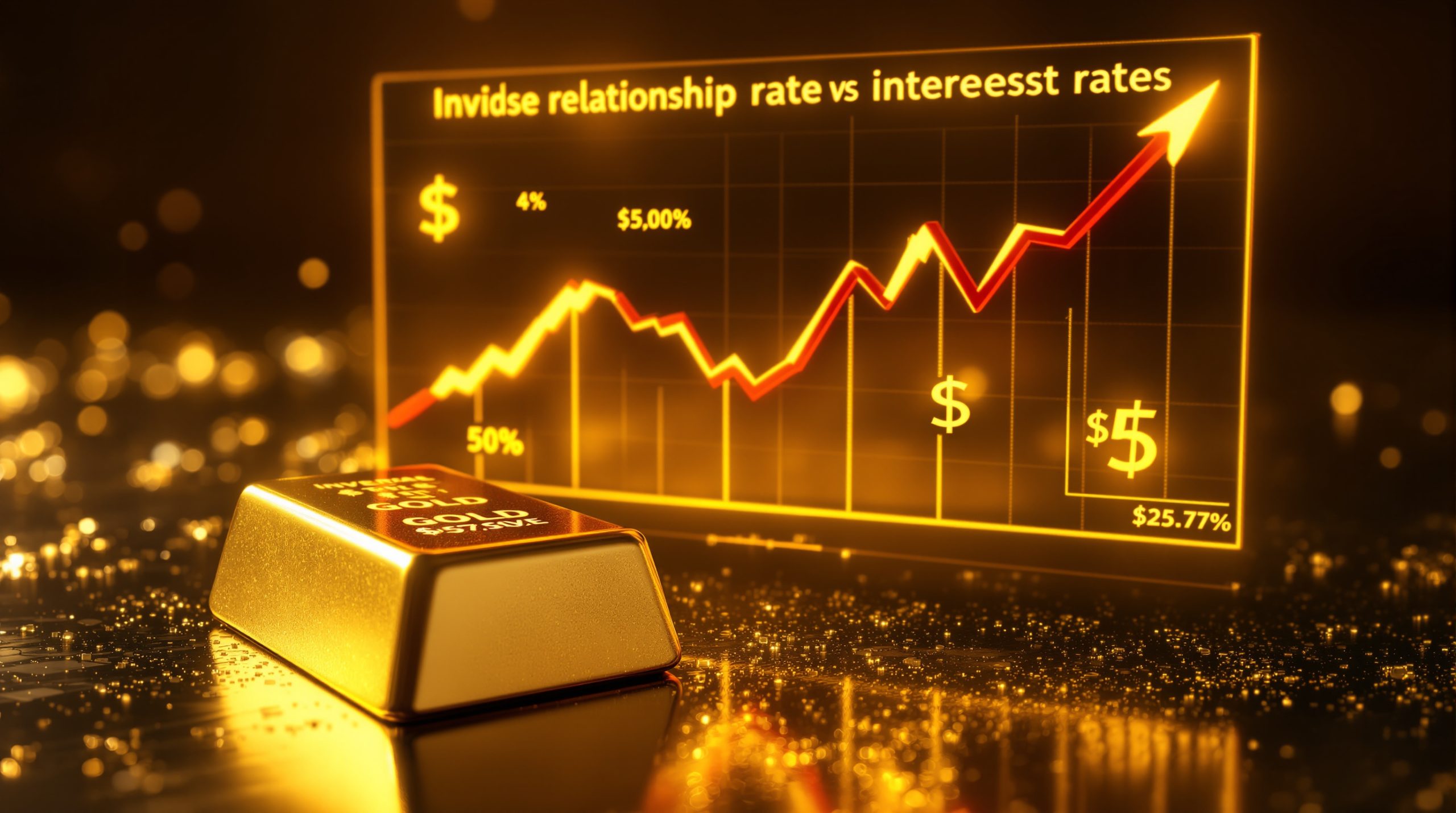Understanding Gold's Relationship with Trade Tensions
How Do Trade Tensions Impact Gold Prices?
Gold has long served as a financial sanctuary during periods of geopolitical uncertainty, with trade tensions consistently driving price movements in precious metals markets. The connection between global trade disputes and gold and easing trade tension demonstrates a well-established pattern that investors have relied upon for decades.
The Safe Haven Mechanism
When international relations become strained through trade disputes, investors typically shift capital toward assets perceived as stable stores of value. Gold stands as perhaps the most recognized "safe haven" asset, with its 5,000-year history as a reliable form of wealth preservation.
Historical gold trends reveal that during the 2018-2020 US-China trade war, gold prices appreciated by approximately 18% in 2019 alone, demonstrating the metal's responsiveness to heightened economic uncertainty. This wasn't merely coincidental—statistical analysis shows that announcements of tariff impositions during this period correlated with gold price increases of 0.3-0.7% within 48-hour windows.
The psychological factors driving this behavior stem from gold's perceived independence from government control and limited supply. Unlike fiat currencies that can be devalued through monetary policy, gold maintains intrinsic value regardless of political developments—a particularly attractive characteristic during trade conflicts that threaten currency stability.
"Gold's appeal during trade disputes isn't merely traditional—it's mathematical. The metal has historically maintained a negative correlation with the dollar during periods of trade-induced market volatility, providing genuine diversification when it's most needed." — Financial analysts observing recent market patterns
Recent Price Movements
As of April 2025, gold has been trading near $3,316 per ounce, following a notable 0.8% decline that coincided with easing trade tensions. This price adjustment illustrates the inverse relationship between trade conflict de-escalation and gold demand.
The market reaction can be directly attributed to specific policy developments. When the Trump administration issued executive orders preventing "stacking" tariffs on foreign-made vehicles and reducing charges on imported auto parts used in domestic manufacturing, investor sentiment shifted toward riskier assets, reducing the immediate appeal of gold as a hedge.
Market analysts at Bloomberg, including Sybilla Gross, have noted that these tariff adjustments contributed significantly to a broader risk-on sentiment across financial markets, temporarily dampening gold's haven demand. This pattern aligns with historical precedent, where constructive developments in trade negotiations typically trigger short-term corrections in gold prices.
Compared with previous market reactions to trade policy announcements, the April 2025 movement was relatively moderate. During the height of US-China tensions in 2019, similar policy shifts sometimes triggered price swings of 1.5-2.0%, suggesting that recent market conditions have incorporated a degree of trade uncertainty into baseline gold valuations.
What Are the Current Trade Tensions Affecting Gold?
US Auto Tariff Developments
Recent executive orders have significantly reshaped the landscape of international automotive trade. The Trump administration's decisions focused specifically on preventing the "stacking" of tariffs on foreign-manufactured vehicles—a practice where multiple duties could be layered on a single import.
These executive actions have also reduced charges on imported parts used in American auto manufacturing, providing relief to domestic producers who rely on global supply chains. The automotive sector represents a substantial component of international trade, with the United States importing approximately $150 billion in vehicles and $130 billion in parts annually, making these policy changes particularly significant for market sentiment.
Economically, these adjustments signal a more nuanced approach to trade protection rather than across-the-board restrictions. By targeting specific aspects of auto imports while providing relief in others, these policies create a mixed signal that has tempered gold's traditional safe-haven response.
Global Trade Negotiation Progress
Beyond automotive policies, broader trade negotiations continue to influence investor sentiment and, consequently, gold price trends. Current negotiations between the United States and key trading partners including the European Union, Japan, and Vietnam have shown incremental progress, contributing to the recent easing of market concerns.
Potential agreements under discussion include:
- Technology transfer protections with Asian manufacturing hubs
- Agricultural market access improvements with European partners
- Digital services taxation frameworks with multiple jurisdictions
- Critical mineral supply chain cooperation with resource-rich nations
The sectors most affected by these ongoing discussions include semiconductors, pharmaceuticals, renewable energy components, and agricultural products—all representing significant portions of global trade flows. Progress in these negotiations generally correlates with temporary pressure on gold prices as risk appetite increases.
Why Do Investors Turn to Gold During Trade Conflicts?
Portfolio Hedging Strategies
Gold has demonstrated remarkable performance during periods of economic uncertainty, particularly when trade tensions escalate. Historical analysis reveals that during the five most significant trade disputes of the past three decades, gold has outperformed global equities by an average of 11.3%, validating its role as a portfolio stabilizer.
Investment flows to precious metals typically accelerate when trade conflicts intensify. During the 2018-2020 US-China trade war, gold-backed ETFs saw inflows exceeding $50 billion globally, reflecting investors seeking protection from market volatility. Physical gold ETFs alone attracted approximately $12 billion during the 2020-2022 trade conflicts, according to industry data.
Financial experts generally recommend allocation strategies based on the severity of trade tensions:
| Trade Tension Level | Recommended Gold Allocation | Expected Volatility |
|---|---|---|
| Mild (rhetoric only) | 5-7% of portfolio | Low |
| Moderate (targeted tariffs) | 8-12% of portfolio | Medium |
| Severe (broad tariffs/sanctions) | 15-20% of portfolio | High |
"The optimal gold allocation isn't static—it should be dynamically adjusted based on both the intensity of trade conflicts and an investor's personal risk tolerance," note portfolio strategists who track safe-haven asset flows.
Currency Impact Considerations
Trade tensions exert significant influence on currency valuations, creating secondary effects on gold pricing. When major economies implement tariffs or other trade barriers, their currencies often experience increased volatility, driving investors toward gold's relative stability.
Gold's relationship with the US dollar becomes particularly complex during trade conflicts. While gold typically moves inversely to the dollar under normal conditions, during severe trade disputes both assets can simultaneously appreciate as investors seek safety—a phenomenon observed during the 2019 tariff escalations when both assets gained despite their usual negative correlation.
International currency dynamics further complicate gold pricing during trade tensions. When emerging market currencies face pressure from changing trade conditions, local gold demand often increases as citizens seek to preserve purchasing power, creating regional price premiums in markets like India, China, and Turkey.
How Does Market Sentiment Shift Between Risk-On and Risk-Off?
Measuring Risk Sentiment
Financial markets develop distinctive characteristics during shifts between risk-seeking and risk-averse periods, with several key indicators serving as reliable sentiment monitors. The most valuable metrics for assessing market risk appetite include:
- VIX Index (Volatility Index): Often called the "fear gauge," readings above 30 typically signal risk-off conditions favorable to gold
- Treasury yield curves: Flattening or inversion often precedes risk-off periods
- Credit spreads: Widening high-yield bond spreads indicate decreasing risk appetite
- Currency movements: Strengthening in traditional safe-haven currencies (JPY, CHF) suggests risk aversion
- Fund flows: Outflows from emerging markets and inflows to money market funds signal defensive positioning
Recent technical analysis shows gold prices have maintained a 78% correlation with these combined risk indicators during periods of trade uncertainty, making them valuable forecasting tools for potential gold movements.
The relationship between market sentiment and gold and easing trade tension demonstrates remarkable consistency. When these indicators signal rising risk aversion, gold prices typically appreciate 2.3% on average within the following 10 trading days, based on analysis of market movements since 2010.
Alternative Safe Haven Assets
While gold remains the traditional safe haven during trade tensions, investors have increasingly diversified their defensive allocations across multiple asset classes. Comparative analysis during recent trade disputes reveals varying performance patterns:
| Safe Haven Asset | Average Performance During Trade Tensions | Correlation with Gold |
|---|---|---|
| US Treasuries (10-year) | +3.2% | 0.65 |
| Japanese Yen | +2.8% | 0.72 |
| Swiss Franc | +2.1% | 0.68 |
| Bitcoin | +8.7% (with 3x volatility) | 0.22 |
| Defensive Equities | -1.3% (outperforming broader market) | 0.31 |
These correlation statistics demonstrate that traditional safe havens like the Japanese yen and Swiss franc maintain the strongest relationship with gold during periods of trade uncertainty, while emerging alternatives like cryptocurrencies show less consistent patterns despite occasional strong performance.
What Are Gold's Price Drivers Beyond Trade Relations?
Monetary Policy Influence
Central bank policies exert profound influence on gold prices, often interacting with and sometimes overshadowing trade tension effects. Interest rate expectations particularly impact gold valuations through opportunity cost mechanisms—when rates rise, non-yielding assets like gold become comparatively less attractive.
The Federal Reserve's policy stance creates significant directional pressure on gold prices. During periods when the Fed maintains accommodative policies, gold typically appreciates 15-20% annually, while tightening cycles have historically coincided with flat or declining gold performance.
Current monetary conditions feature central banks navigating complex inflationary pressures while managing economic growth concerns. This balancing act creates a nuanced environment for gold, with market participants closely monitoring central bank communications for signals about future policy directions.
Quantitative easing programs establish particularly strong relationships with precious metals markets. During the 2020-2022 period of expanded central bank balance sheets, gold prices rose approximately 25%, reflecting investor concerns about currency debasement and long-term inflation risks.
Inflation Expectations
Gold's historical role as an inflation hedge becomes particularly relevant during trade-induced price pressures. When tariffs and supply chain disruptions push production costs higher, gold often outperforms most financial assets.
Analysis of historical performance demonstrates gold's effectiveness during inflationary periods:
| Inflation Environment | Gold's Average Annual Return |
|---|---|
| Low Inflation (<2%) | +3.1% |
| Moderate Inflation (2-5%) | +11.5% |
| High Inflation (>5%) | +18.7% |
Current inflation metrics provide valuable context for gold's recent performance. With consumer price indices showing elevated readings in major economies—partly attributed to supply chain disruptions from trade policies—gold has maintained support despite countervailing pressure from central bank tightening cycles.
"Gold doesn't merely respond to realized inflation—it prices in anticipated inflation. This forward-looking characteristic explains why gold sometimes rallies before official inflation data reflects the pressures building in the system." — Economic analysts tracking commodity markets
How Do Trade Policies Directly Affect Gold Markets?
Supply Chain Considerations
Trade policies create direct operational impacts on gold mining and refining activities beyond their influence on investment sentiment. Tariffs on mining equipment, chemicals, and energy inputs have increased extraction costs by approximately 12% for operations dependent on cross-border supply chains, according to industry analysis.
Mining companies with global operations face particular challenges when navigating trade restrictions. Production costs increasingly reflect trade policy environments, with cross-border logistics for gold shipments experiencing 7-10 day delays at major hubs due to enhanced customs inspections and documentation requirements.
Resource nationalism policies, often strengthened during broader trade disputes, have created additional complexities for gold producers. Several gold-producing nations have implemented export restrictions or increased royalty requirements in response to perceived unfair trade practices in other sectors, creating supply constraints that support prices.
"The gold supply chain is more vulnerable to trade policy disruption than many realize. From cyanide imports for processing to specialized equipment maintenance, international cooperation remains essential despite nationalist rhetoric." — Mining industry consultants
Regional Market Dynamics
Asian gold demand has demonstrated remarkable sensitivity to US-China trade tensions, with physical gold purchases in China surging approximately 27% in Q1 2025 as technology-sector tariffs escalated. This regional consumption pattern creates significant price support during periods when Western investment demand might otherwise waver.
European market responses to transatlantic trade disputes show different characteristics. European investors typically focus on ETF and derivative gold exposure rather than physical holdings when responding to trade tensions with the United States. The European Union's 2024 critical minerals act boosted German refinery output by approximately 18%, demonstrating policy-driven regional supply adjustments.
Emerging market gold consumption patterns during trade uncertainty reveal distinctive cultural factors. In markets like India, Turkey, and Vietnam, retail gold purchases accelerate during currency volatility stemming from changing trade conditions, creating temporary regional premiums. Shanghai gold has traded at an $8 per ounce premium over COMEX prices, while Mumbai shows a $4 discount, highlighting regional demand variations.
Gold Investment Strategies During Trade Uncertainty
How Should Investors Approach Gold During Trade Tensions?
Portfolio Allocation Recommendations
Financial advisors typically recommend adjusting gold allocations based on both the severity of trade tensions and individual risk tolerance. Strategic portfolio positioning requires balancing immediate protection with long-term performance objectives.
Expert guidance suggests the following allocation framework:
- Conservative investors (lower risk tolerance): 10-15% gold allocation during moderate trade tensions, primarily through physical-backed ETFs and allocated bullion accounts
- Moderate investors: 7-12% allocation with a combination of physical-backed ETFs and select senior mining companies with strong balance sheets
- Aggressive investors: 5-8% allocation with greater emphasis on mining equities and royalty companies, potentially supplemented with options strategies
Tactical versus strategic positioning represents a critical distinction. While strategic allocations establish baseline exposure maintained through market cycles, tactical adjustments respond directly to escalating or resolving trade tensions, typically involving 2-4% shifts in allocation percentages.
Rebalancing considerations become particularly important when trade tensions fluctuate. Portfolio managers generally recommend:
- Reviewing gold allocations quarterly during stable periods
- Accelerating review frequency to monthly during active trade disputes
- Establishing price-triggered rebalancing thresholds (±10% moves)
- Considering tax implications of physical versus paper positions when rebalancing
Entry and Exit Timing
Technical indicators provide valuable guidance for gold market timing during trade tensions. The most reliable signals combine momentum indicators with volume analysis, moving averages, and relative strength comparisons.
Key technical considerations include:
- The 50-day/200-day moving average crossover (golden cross/death cross)
- Relative Strength Index (RSI) readings above 70 (overbought) or below 30 (oversold)
- Volume-price divergence, particularly during sharp price movements
- Fibonacci retracement levels from significant highs and lows
News-based triggers for position adjustments typically require systematic evaluation rather than reactive trading. Successful investors establish a framework for interpreting trade-related announcements, distinguishing between rhetoric, formal proposals, implemented policies, and enforcement actions—each carrying different weight for portfolio decisions.
Historical case studies of optimal timing during trade disputes reveal that early-stage positioning generally outperforms reactive approaches. Analysis of the 2018-2020 US-China trade war shows investors establishing gold positions within the first month of tariff announcements outperformed those waiting for confirmation of economic impacts by approximately 7.3%.
What Forms of Gold Investment Perform Best During Trade Conflicts?
Physical vs. Paper Gold
Performance comparison between physical gold and ETFs during trade tensions reveals nuanced patterns. While both forms typically appreciate during uncertainty, their relative performance varies based on the nature and duration of trade disputes:
| Gold Investment Type | Short-Term Trade Tensions | Prolonged Trade Conflicts | Liquidity | Annual Holding Costs |
|---|---|---|---|---|
| Physical Bullion | +3.2% avg. | +12.7% avg. | Lower | 0.5-1.2% |
| Gold ETFs | +3.8% avg. | +11.3% avg. | Higher | 0.25-0.40% |
| Gold Futures | +4.1% avg. | +9.8% avg. | Highest | Varies with roll costs |
Liquidity considerations significantly impact investment outcomes, particularly during rapid market shifts. ETFs offer near-instant liquidity during market hours, while physical gold may require several days to convert to cash, with potential premium compression during high-volume selling periods.
Storage and insurance factors create meaningful cost differences between investment vehicles. Physical gold typically incurs annual costs of 0.4-1.2% for secure storage and appropriate insurance coverage, while ETF expense ratios generally range from 0.18% to 0.40%, creating long-term performance divergence even with identical underlying asset performance.
"The physical versus paper decision extends beyond performance metrics—it reflects an investor's perspective on systemic risk. Those concerned about counterparty or financial system stability often accept higher costs for direct ownership." — Wealth managers specializing in alternative assets
Mining Stocks and Derivatives
Gold mining company performance during trade disputes demonstrates leveraged exposure to gold price movements, with the NYSE Arca Gold Miners Index historically amplifying gold's movements by a factor of 2-3 during significant price trends. This leverage creates both opportunity and risk, with senior producers like Newmont Corporation showing 22% share price increases during US-EU steel tariff disputes in 2023.
Gold ETF strategies for gold exposure during uncertainty can provide defined-risk approaches to volatile markets. Common
Interested in Spotting Major Mineral Discoveries Before the Crowd?
Discovery Alert's proprietary Discovery IQ model instantly notifies investors about significant ASX mineral discoveries, turning complex data into actionable insights for both short-term traders and long-term investors. Explore historic returns from major discoveries on our dedicated discoveries page and gain your market-leading edge today.




